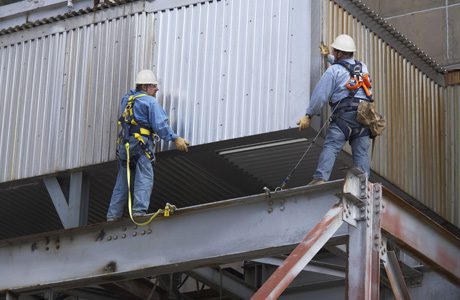
Test your knowledge and make sure you know what the real threats are, suggests Stuart Linnitt, Global Engineered Systems Manager at Capital Safety, a 3M company
According to the Health & Safety Executive (HSE), working at height remains one of the biggest causes of fatalities and major injuries. Employers and employees have a legal duty to take reasonable care of themselves and others who may be affected by their actions.
In its approach to risk management, the HSE requires all employers to follow a hierarchy of control measures. In relation to working at height, this involves avoiding the need to work at height where possible; where it cannot be avoided, to use equipment or other measures to prevent falls and ultimately, where the risk of a fall cannot be eliminated, to use equipment or other measures that minimise the distance and consequences of a fall.
But how do you know whether the actions you have taken to ensure your safety and the safety of others is effective? Unfortunately there are many myths associated with working at height, which can compromise workers’ and employers’ ability to provide the safest possible working environment.
Myth one: It’s CE marked so it must be safe
One of the greatest myths prevalent within the world of working at height is the belief that if your personal protective equipment is CE marked then it must be safe to use. This can stem from a lack of knowledge and a desire to procure the cheapest solution. Too often, companies may focus on meeting minimum legislative or site requirements, without understanding the requirement of the task in detail.
For example, many do not appreciate that the typical test mass utilised to validate commonly used fall arrest equipment is 100kg, which given that the Office of National Statistics (ONS) male weight / height averages of 175cm (5’9”) 84kg (13st) – seem reasonable, until you consider the extra weight which workers at height may be carrying, such as full tool belts.
CE EN conformity marks assure that a product meets minimum European agreed criteria, which as stated, is a minimum requirement. Focused manufacturers, however, will strive to go above and beyond this to improve performance, longevity, comfort, functionality and use parameters way beyond the established compliance minimums.
Myth two: All PFPS are fit for all jobs
Do the purchasers of personal fall protection systems (PFPS) actually understand how such equipment works, its capabilities and limitations? If this is not fully understood, then fall protective equipment can actually exacerbate risk. Take the example, of a worker operating in close proximity to unfinished concrete edges, attached to a designed EN795 anchor at foot level, using an EN355 lanyard attached correctly to an EN361 full body harness, all of which are CE marked. If these have not been tested over ‘sharp edges’ they could fail and as such, the user is exposed to a risk that is arguably enhanced as it is unlikely to be apparent to be them. At first glance the worker is compliant but in reality the risk has not been sufficiently assessed and the resulting mitigation strategy is accordingly flawed.
For equipment to be effective it must be properly specified in the first instance and there is by no means a ‘one-size-fits-all’ solution. Various systems are available, none of which should be considered as sufficient on its own.
Restraint: restraint equipment involves a positioning system that holds the worker in place while keeping his or her hands free to work. While restraint or positioning equipment may be used to prevent a worker from reaching a fall hazard position, it is not specifically designed to arrest a fall.
Suspension: suspension equipment, such as a cradle, lowers and supports the worker while providing a hands-free work environment. Again, a suspension system’s components are not designed to arrest a free fall, so using a back-up fall arrest system is critical.
Fall arrest: if there is any risk that a worker may fall from an elevated position, a fall arrest system is required. Fall arrest systems activate only when the actual fall occurs and typically consist of a full-body harness with a shock-absorbing lanyard or retractable lifeline, an anchor point and a means of rescue.
Rescue/retrieval: in the event of an arrested fall, retrieval equipment is needed to rescue a worker bringing them to safety. This equipment can either allow for self-rescue or rescue by a co-worker or rescue team, depending on the particular situation. Devices include tripods, davit arms, winches and comprehensive rescue systems.
Making sure that the PFPS chosen is right for the task is, however, is only part of the equation. It is also essential to ensure that it is acceptable to the person using it. If the user finds the equipment uncomfortable, difficult to use or feels that it hinders work, there will be the temptation to avoid using it or to use it in a way that compromises its performance.
Myth three: I don’t have to inspect my equipment every time I use it, surely?
As with all PFPS, stringent inspection and maintenance regimes for PFPS are as important to worker safety as choosing the right system in the first place. Regulation 12 of the Work at Height (WAH) regulations set out duties for the inspection of equipment. While it does not give information about the criteria for individual products, it does offer general advice on inspection regimes and information on the frequency, procedure and level of detail of inspections, as well as the type of records that must be kept. In addition to what is needed under the WAH regulations, there are also requirements for inspection in BS EN 365:2004 (the British Standard for personal protective equipment against falls from a height) and recommendations in BS 8437: 2005 (code of practice for selection, use and maintenance of PFPS) and Health & Safety Executive Publication INDG367 (inspecting fall arrest equipment made from webbing or rope). Product-specific inspection requirements are provided by equipment manufacturers and should be incorporated into the inspection regime.
There are practical reasons for ensuring that inspection is a routine part of PFPS use. Materials used in the equipment can degrade over time irrespective of the situation in which they are used, but a common cause of loss or strength is through abrasion or by damage such as cuts from sharp edges for example. Any equipment showing signs of this type of wear should be scrapped as should any that has suffered a high shock load.
Equipment should be checked before every use, preferably by the worker using it. The process need only take a few minutes, but should include a detailed visual check of webbing, rope or any other textile element, and a check on the function of components such as connectors, anchor line devices, buckles on harnesses, descending and ascending devices and retractable-type fall arresters.
Myth four: We don’t need specific training
Fatal falls are not just the result of a lack of proper safety equipment. They can equally result from the absence of training and/or a lack of operative understanding of how to use it and why it is important. The best PFPS in the world may not keep workers safe unless they are trained to use it. All employers in the construction industry should provide training programmes tailored to specific job tasks and the environment in which they are carried out. Training sessions should not be confined solely to the individual piece of PFPS but should encompass:
– Identification, elimination and control of potential fall hazards
– Inspection, use and maintenance of PFPS on a regular basis
– Carrying out the routine of a fall protection plan
– Compliance with applicable industry standards.
WAH regulations require that anyone using personal PFPS should be properly trained by a ‘competent person’. The regulations do not mandate specific qualifications for a competent person, but this should be someone capable of identifying risks and with the authority to carry out measures to eliminate them. Every company should identify competent persons to oversee its fall protection plan, conduct fall protection training and ensure all employees are properly prepared before they begin work.
Specialist PFPS equipment manufacturers like Capital Safety can offer training programmes which combine classroom or e-learning training backed up by hands-on training. Whilst the former can ensure full understanding of the demands of legislation, the need for the right type of equipment and the importance of maintaining equipment, the latter allows workers to get to grips with equipment in a controlled environment. There is no substitute for donning a harness and having it adjusted properly, connecting to an anchor and experiencing how it feels or for seeing first-hand what needs to be inspected before use. On site, hands-on training is to be recommended as this ensures any theory covered in the classroom is applied to a particular work environment in practice.
The breadth of fall risk mitigation solutions is ever expanding, through technological advancement and the wider use of lightweight, high-performance materials. Much is now focused on ergonomic factors and application specific design and or environments. The effectiveness of PFPS in mitigating the specific risk identified must always be very carefully considered. Falling is seriously unpleasant at best, catastrophic at worst and generally, in many work environments foreseeable, so research into the correct equipment, and investment in training to ensure its correct deployment is crucial.
For more information, visit: www.capitalsafety.com
For more information on the Capital Safety training services, visit: www.capitalsafety-training.com/uk






